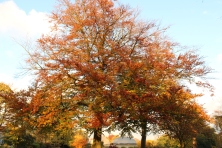This year’s Broomhill Festival in Sheffield begins on 15th June and I am delighted to be taking part in it. Jonny Ingall (cello), Roy Phillips (piano) and I will perform a lunchtime concert in the lovely setting of St Mark’s Church on Friday 22nd June at 1pm. The festival is titled By the community, for the community, and proceeds from our concert will be donated to St Luke’s Hospice in Sheffield. Tickets are available on the door and the suggested donation is £7-£10.
Our programme is very varied, with music by Haydn, Clarke, Popper, Summer and Kreisler, as well as two pieces by Antonín Dvořák: the Romance for violin and piano and Andante moderato from the Dumky Trio. Romance dates from 1877, but the piece started life as the slow movement of his String Quartet in F minor, op. 9. When the quartet failed to be as popular as Dvořák had hoped, he reworked and extended the movement in two versions: for violin and piano, and violin and orchestra. After a long introduction on the piano, the violin plays a beautiful, song-like melody, in which the influence of Slavonic folk music can be heard. The middle section of the piece is very dramatic, with virtuosic figurations in the solo part, before the main theme returns.
Dvořák’s Trio in E minor, subtitled Dumky, was completed in 1891 and premiered in Prague the same year, with the composer on piano. The work is unusual in structure, as it is in six main sections. Dvořák used the Duma as his basis – this is a Slavic term referring to epic ballads and songs of lament, and composers in the 19th century began using it as a classical form to indicate a despondent and introspective composition, interspersed with brighter sections. The main theme of the fourth movement of the Dumky Trio is a soaring, passionate melody played by the cello. Lighter, scherzo-like sections are provided by the violin and piano.









